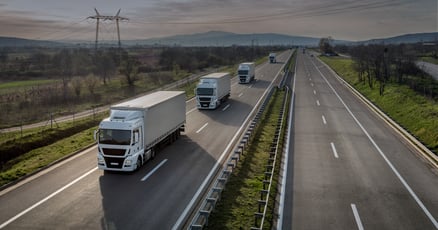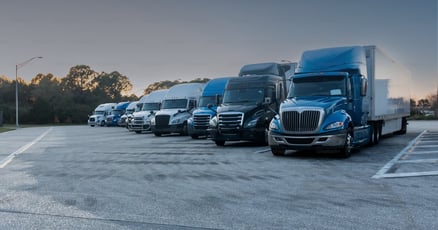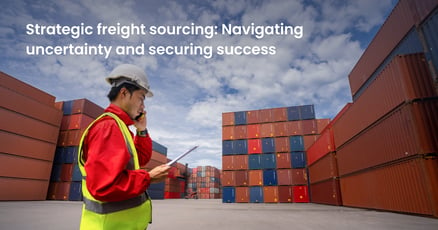-
Products Products
- Industry
- Initiatives
- Resources
- Company
- Book a demo

Before you go: Logistics leaders just dropped the truth on AI
The State of AI in Logistics 2025 is here — no hype, just real conversations and raw insights.
Subscribe to our newsletter
to get regular updates
Subscribe Here!
Featured Articles
Pando News
Pando named a Leader by G2 in the Grid® Report | Spring 2025
Setting new benchmarks with 13 prestigious badges across TMS, Freight Management, and Supply Chain ...
Read more
Agentic AI
The Surcharge Frenzy: How AI Agents Are Solving Freight Rate Management Chaos in 2025
Transform weekly carrier surcharge chaos into competitive advantage with AI agents that automate ...
Read more
Agentic AI
The End of EDI: Why AI Agents Are Revolutionizing Freight Operations
Explore how AI agents outperform traditional EDI with flexible document processing, reduced costs, ...
Read more
Supply Chain Trends and Insights
The Tariff Scramble: Winning Strategies for the 90-Day US-China Trade Ceasefire
Discover how forward-thinking logistics leaders are turning tariff volatility into competitive ...
Read more- Select Topics
- Agentic AI
- Freight Audit & Payment
- Transportation Management System
- Industry Deep Dive
- Supply Chain Trends and Insights
- Supply Chain Management
- Freight Procurement
- Supply chain trends & insights
- Sustainability
- Pando News
- Freight Planning and Optimization
- Featured
- Pando Customer

Pi Named in Fast Company's Next Big Things in Applied AI for Taming Logistics Chaos
8 mins read • Sridhar C S

Multi-Currency, Multi-Mode Payment Orchestration: AI Agents as Global Finance Operators
15 mins read • Sridhar C S

Autonomous Dispute Resolution: How AI Agents Fight and Win Carrier Overcharges
16 mins read • Sridhar C S

Autonomous Costing and Recovery: How AI Agents Calculate Costs Before Invoices Arrive
13 mins read • Sridhar C S

The Exception Management Revolution: From 15-Hour Queues to 1-Hour Weekly Reviews
13 mins read • Sridhar C S

Beyond OCR: How AI Agents Actually Read and Understand Freight Invoices
10 mins read • Sridhar C S

The Freight Talent Exodus: Why Manual Freight Audit Teams Can't Scale
17 mins read • Sridhar C S

Why Your Current Freight Audit Setup Is Obsolete (And Getting More Obsolete Every Day)
10 mins read • Sridhar C S

The Freight Audit Death Spiral: How Error Rates Are Killing Logistics Profitability
11 mins read • Sridhar C S

The Payment Recovery Crisis: Why Freight Overcharges are Never Recovered
15 mins read • Sridhar C S

Crossing the AI Chasm: Your Roadmap to Deploying AI Agents in Freight Audit & Pay
12 mins read • Sridhar C S

AI Agents Unleashed: The Complete Guide to What Autonomous Freight Audit Actually Looks Like
11 mins read • Sridhar C S

The Great Logistics AI Agents Reckoning: Why Your Freight Audit & Pay Is Living on Borrowed Time
17 mins read • Sridhar C S

Pando Recognized as a 2025 Great Supply Chain Partner by SupplyChainBrain
5 mins read • Sridhar C S

Quick Wins, Not Quick Sand : The Smarter Path to Logistics AI Success
7 mins read • Prakash Ramnath

The Surcharge Frenzy: How AI Agents Are Solving Freight Rate Management Chaos in 2025
9 mins read • Prakash Ramnath

The End of EDI: Why AI Agents Are Revolutionizing Freight Operations
10 mins read • Prakash Ramnath
Pando named a Leader by G2 in the Grid® Report | Spring 2025
6 mins read • Sridhar C S

The Tariff Scramble: Winning Strategies for the 90-Day US-China Trade Ceasefire
7 mins read • Sridhar C S

AI Agents: Revolutionizing Container Load Planning for Smarter Logistics
8 mins read • Durga Pratiha

Shelf Space at Stake: How Retailers Can Navigate the Tariff Storm
4 mins read • Sridhar C S

Beyond the Cold Chain: Protecting Pharmaceutical Integrity Amidst Tariff Turbulence
4 mins read • Sridhar C S

When Every Channel Matters: Consumer Products Logistics in the Tariff Era
4 mins read • Sridhar C S

Chemical Supply Chains in Turmoil: How Can Organizations Navigate the Tariff Storm
4 mins read • Sridhar C S

Just-in-Time Meets Just-in-Case: Automotive Supply Chains Navigate the Tariff Crisis
4 mins read • Sridhar C S

Carbon Crossroads: How Shippers Can Navigate the Dual Impact of Tariffs and Maritime Decarbonization
7 mins read • Sridhar C S

The 90-Day Window: Why AI Agents Are Essential for Navigating Trade Policy Volatility
7 mins read • Sridhar C S

Liberation Day Tariffs: How Trump’s New Trade Policy Is Sending Shockwaves Across Global Logistics
10 mins read • Sridhar C S

The End of Spreadsheet Purgatory: Why AI is Essential for Freight Procurement in 2025
10 mins read • Sridhar C S

Navigating the US Tariff Storm: How Manufacturing and Retail Logistics Teams Can Adapt
7 mins read • Prakash Ramnath

Becoming a ‘Shipper of Choice’ with AI Agents that Revolutionize Carrier Relationships
8 mins read • Nitin Jayakrishnan

Unbundling logistics outsourcing: How AI is disrupting outsourced freight management
6 mins read • Nitin Jayakrishnan

Manual shipment creation is holding you back: Why AI agents are now essential
8 mins read • Durga Pratiha

The next leap in logistics: How AI agents redefine international Transportation Management Systems
7 mins read • Durga Pratiha

Pando named a Leader by G2 in the Grid® Report | Winter 2025
6 mins read • Durga Pratiha

How CSCOs can make gen AI honor its productivity promise in 2025
7 mins read • Sridhar C S

US logistics at the crossroads: Key investment focal points for CSCOs in 2025
9 mins read • Sridhar C S

US logistics at the crossroads: Key trends driving change in 2025
8 mins read • Sridhar C S

Leveraging AI and machine learning for predictive supply chain risk management
6 mins read • Rohit Lakshman

Creating a sustainable transport planning: A comprehensive guide for logistics planners
11 mins read • Rohit Lakshman

Beyond the pandemic: Evolving landscape of supply chain disruptions
8 mins read • Rohit Lakshman

The future of supply chain: Trends that will define 2024 and beyond
6 mins read • Rohit Lakshman

Transportation management system: A complete guide for logistic success
10 mins read • Rohit Lakshman

The freight audit industry: Navigating complexity and maximizing savings
9 mins read • Rohit Lakshman

Freight management system: Transforming logistics for modern businesses
10 mins read • Rohit Lakshman

In-house vs. outsourced freight audit: A TCO breakdown
11 mins read • Rohit Lakshman

Navigating customs clearance in international freight shipping
8 mins read • Rohit Lakshman

Freight pre audit: A proactive approach to cost management
10 mins read • Rohit Lakshman

Freight audit and payment market: Trends for efficiency and cost savings
8 mins read • Rohit Lakshman

Arresting cost leakages due to fraud: The role of intelligent auditing systems
5 mins read • Durga Pratiha

Freight audit best practices: Maximizing accuracy and efficiency in logistic operations
7 mins read • Rohit Lakshman

The ultimate guide to freight sourcing: Key strategies, challenges, and best practices
9 mins read • Rohit Lakshman

Redefine freight negotiation strategies with next-gen intelligence
7 mins read • Durga Pratiha

Transportation sourcing 101: Building a resilient and agile logistic network
8 mins read • Rohit Lakshman

Freight procurement: Meaning, benefits and best practices for optimized logistics
10 mins read • Rohit Lakshman

Freight audit explained: A guide to logistic success
8 mins read • Rohit Lakshman

10 best practices for strategic freight post-audit insights
11 mins read • Rohit Lakshman

Minimizing cost leakages in logistics: Top 10 freight audit and payment best practices
10 mins read • Rohit Lakshman

Data-driven decisions: Leveraging your freight audit payment company for insights
8 mins read • Rohit Lakshman

The rise of generative AI in supply chain management: Opportunities and challenges
8 mins read • Rohit Lakshman

Rethinking freight bidding: Achieve efficiency and agility with AI agents
7 mins read • Durga Pratiha

The impact of AI on freight procurement to payment - Driving efficiency and controlling costs
7 mins read • Rohit Lakshman

Pando recognized in the Gartner® Market Guide for Multienterprise Collaboration Networks
5 mins read • Sridhar C S

Transportation management strategy - Fundamental components for achieving success
11 mins read • Rohit Lakshman

Freight management: Reshaping logistics supply chains in the digital age
10 mins read • Rohit Lakshman

Leveraging AI in Freight & Logistics: A Comprehensive Overview (Part 1)
7 mins read • Rohit Lakshman

Leveraging AI in Freight & Logistics: A Comprehensive Overview (Part 2 )
5 mins read • Rohit Lakshman

Transforming freight procurement workflows with agentic AI for bid optimization
5 mins read • Durga Pratiha

Enhance freight procurement with AI agents for smarter lane selection
7 mins read • Durga Pratiha

Demystifying freight calculator features: Understanding what you really need
8 mins read • Rohit Lakshman

Understanding freight rates: Hidden factors that impact shipping costs
15 mins read • Rohit Lakshman

The million dollar question: Why logistics experts believe in a future of AI-powered freight procurement?
8 mins read • Sridhar C S

How AI copilots redefine user experience and decision-making in transportation management
11 mins read • Rohit Lakshman

The ultimate AI guide for logistics professionals
7 mins read • Rohit Lakshman

Driving green logistics with the power of route optimization
8 mins read • Rohit Lakshman

Strategic freight sourcing in volatile market conditions: How to navigate uncertainty and secure competitive rates
6 mins read • Rohit Lakshman

Building competitive advantage: How TMS solution transforms your business to offer a differentiated customer experience
7 mins read • Rohit Lakshman

Navigating complexity: The unique challenges of pharmaceutical supply chains
9 mins read • Rohit Lakshman

Proactive strategies for managing supply chain disruptions
7 mins read • Rohit Lakshman

Navigating global challenges: The complexities of international logistics shipments
9 mins read • Rohit Lakshman

Power of connected supply chains through integrated order management system
9 mins read • Rohit Lakshman

Real-time visibility: For an efficient auto supply chain management
8 mins read • Rohit Lakshman

The Human element in global supply chains: Building a high-performing team
5 mins read • Rohit Lakshman

The ethical implications of AI in delivery optimization: Addressing bias and transparency
8 mins read • Rohit Lakshman

The role of international shipping in E-commerce expansion: Opportunities and challenges
5 mins read • Rohit Lakshman

TMS shipping: Need for a unified platform for end-to-end visibility and control
10 mins read • Rohit Lakshman

Leveraging logistics consulting to build business case for AI investment in transportation and logistics
8 mins read • Rohit Lakshman

Ransomware in retail logistics: Preventing supply chain outages in a threat-filled landscape
8 mins read • Sridhar C S

Ensuring safety and quality: The critical role of pharmaceutical logistics
9 mins read • Rohit Lakshman

Global logistics under Trump administration: A new normal for shippers
9 mins read • Jim Hilbert

The Backbone of business: Critical role of logistics in supply chain management
7 mins read • Rohit Lakshman

Understanding the hurdles: Challenges of traditional route planning
8 mins read • Rohit Lakshman

How modern TMS solutions are transforming logistics operations for shippers
10 mins read • Rohit Lakshman

Reclaiming control: Why chemical manufacturers must rethink their logistics strategy
8 mins read • Durga Pratiha

Catalyzing growth: The strategic supply chain powering US chemical dominance - Part 2
7 mins read • Durga Pratiha

Beyond the basics: Advanced strategies for optimizing international logistics
7 mins read • Rohit Lakshman

Catalyzing growth: The strategic supply chain powering US chemical dominance - Part 1
8 mins read • Durga Pratiha

The role of data analytics in modern freight management
6 mins read • Rohit Lakshman

Curb freight rate volatility in logistics sourcing with smart tech
6 mins read • Rohit Lakshman

Geopolitical landscape of global trade: Complex tapestry
7 mins read • Rohit Lakshman

Omnichannel order fulfillment enhancing customer delight
6 mins read • Rohit Lakshman

Leverage AI for resilient, anti-fragile logistics and transportation management
7 mins read • Rohit Lakshman

Predictive analytics and AI: Future of supply chain
8 mins read • Rohit Lakshman

Navigating the complex world of freight forwarding: A comprehensive guide
6 mins read • Rohit Lakshman

Procurement in 2024 and beyond: Key trends to watch out for
6 mins read • Rohit Lakshman

Last-mile delivery: The final frontier of retail supply chain efficiency
8 mins read • Rohit Lakshman

How advanced technology is revolutionizing omnichannel strategy
5 mins read • Rohit Lakshman

Optimizing cash flow: Strategies for efficient freight bill payment
7 mins read • Rohit Lakshman

Data-driven decision making: The power of unified supply chain management software
5 mins read • Rohit Lakshman

Navigating the ocean freight landscape: A comprehensive guide
6 mins read • Rohit Lakshman

Importance of logistics in supply chain management
6 mins read • Rohit Lakshman

Identifying the best transportation management systems: Top TMS features and benefits
7 mins read • Rohit Lakshman

Evaluating the true value of your freight audit payment company
7 mins read • Rohit Lakshman

Port strike 2024: What shippers need to know?
7 mins read • Durga Pratiha

Freight forwarding made simple
4 mins read • Rohit Lakshman

Freight procurement approach: A guide to modern logistics procurement
8 mins read • Rohit Lakshman

From lab to patient: Decoding the pharmaceutical supply chain landscape – Part 2
6 mins read • Durga Pratiha

From lab to patient: Decoding the pharmaceutical supply chain landscape - Part 1
9 mins read • Durga Pratiha

Pando named a Leader by G2 in the Grid® Report | Fall 2024
6 mins read • Durga Pratiha

Build a collaborative multimodal freight partnership with a unified TMS — A complete guide
7 mins read • Rohit Lakshman

6 freight audit best practices: Your essential checklist
9 mins read • Rohit Lakshman

Beyond the basics: The art and science of modern supply chain management
6 mins read • Rohit Lakshman

Beyond the bottom line: The hidden costs of outsourcing freight audit
5 mins read • Rohit Lakshman

What is multi-modal transportation and how to choose the right mode for your shipment
8 mins read • Rohit Lakshman

Maximizing the ROI of your freight bill audit: Leveraging freight post audit findings
5 mins read • Rohit Lakshman

From reg flags to reliability: Choosing the right freight audit partner
5 mins read • Rohit Lakshman

Beyond freight audit companies: When to bring freight audit and payment under your roof
11 mins read • Rohit Lakshman

AI-powered automation — The future of freight bill post audit process
5 mins read • Rohit Lakshman

6 steps to reduce hidden transportation costs with a transportation management system
10 mins read • Rohit Lakshman

Augmenting faster value across your supply chains with AI in route optimization
7 mins read • Rohit Lakshman

How technology and innovation are reshaping the world of multimodal logistics
7 mins read • Rohit Lakshman

Pick the right TMS for your multimodal shipping operations
6 mins read • Rohit Lakshman

Adaptive TMS: A critical cog in the wheel of supply chain future-proofing
7 mins read • Rohit Lakshman

Insourcing vs. outsourcing logistics: A strategic imperative for the pharmaceuticals industry
7 mins read • Durga Pratiha

Industry landscape and supply chain trends reshaping the Consumer-Packaged Goods (CPG) Industry – Part 2
6 mins read • Durga Pratiha

How freight pre-audits put you on the financial front foot
5 mins read • Rohit Lakshman

Beyond On-time delivery: How automated payments enhance carrier loyalty
5 mins read • Rohit Lakshman

4 ways AI optimizes delivery planning for smarter deliveries
7 mins read • Rohit Lakshman

Industry landscape and supply chain trends reshaping the Consumer-Packaged Goods (CPG) industry – Part 1
6 mins read • Durga Pratiha

Bringing logistics in-house: A strategic decision for automotive companies
7 mins read • Durga Pratiha

Logistics procurement 101: Intro to the business of procuring transportation
5 mins read • Rohit Lakshman

TMS solutions: Guide for streamlining modern logistics and transportation
9 mins read • Rohit Lakshman

Unveiling the power of TMS: How it streamlines your supply chain
6 mins read • Rohit Lakshman

From plan to pandemonium: Why the supply chain planning-execution gap is your biggest bottleneck
6 mins read • Durga Pratiha

Outsourcing vs. Insourcing Logistics: A strategic imperative for CPG industry
5 mins read • Prakash Ramnath

The data-driven advantage: How TMS software empowers businesses with supply chain insights
5 mins read • Rohit Lakshman

Agile supply chain: Strategies and benefits of building a flexible and responsive supply chain
7 mins read • Rohit Lakshman

Internal freight audits and payment solutions for spend control
3 mins read • Rohit Lakshman

Gears in motion: Decoding the unique logistics challenges of the automotive sector – Part 2
8 mins read • Durga Pratiha

Managing inhouse vs outsourced logistics debate: A strategic perspective for retail industry
6 mins read • Prakash Ramnath

Gears in motion: Decoding the unique logistics challenges of the automotive sector – Part 1
9 mins read • Durga Pratiha

Your guide to success in the US retail industry in 2024: Part 2
7 mins read • Durga Pratiha

Optimizing every mile: How advanced delivery route planning strategies can improve customer experience
6 mins read • Rohit Lakshman

No-nonsense guide to logistics planning for supply chain strategy
8 mins read • Rohit Lakshman

Managing in-house vs outsourced logistics debate: A perspective for industrial manufacturing companies
6 mins read • Durga Pratiha

Your guide to success in the US retail industry in 2024: Part 1
7 mins read • Durga Pratiha

The Closed Loop Revolution – How circular economy is reshaping global supply chain and logistics
8 mins read • Durga Pratiha

Ship it green – Bringing a sustainability lens to freight sourcing
9 mins read • Prakash Ramnath

Top 7 use cases of generative AI in building smarter supply chains
8 mins read • Prakash Ramnath

Is your TMS equipped for international shipping? Here's what you're missing.
8 mins read • Durga Pratiha

Pando named a Leader by G2 in the Grid® Report | Spring 2024
3 mins read • Durga Pratiha

From harvest to freezer: The secrets behind a leading frozen fruit supply chain
4 mins read • Durga Pratiha

How to implement TMS and realize value faster? – Part 2
7 mins read • Badrinath Setlur

Freight optimization: Understanding the three core pillars
6 mins read • Gururag Kalanidhi

From footprint to foresight: Measuring sustainability for a responsible supply chain
6 mins read • Durga Pratiha

How to implement TMS and realize value faster? – Part 1
6 mins read • Badrinath Setlur

LeaderSpeak : Unlocking value with digital procurement featuring Richard Hesse
4 mins read • Durga Pratiha

How the red sea crisis disrupts logistics and the role of technology
6 mins read • Durga Pratiha

Rate management: Solving the rubik’s cube of freight sourcing and FAP
6 mins read • Durga Pratiha

Collaborative execution : Transforming supply chain through shared vision and action
4 mins read • Durga Pratiha

Building a business case to invest in Transportation Management System – Part 2
7 mins read • Ganesh Iyer

Building a business case to invest in Transportation Management System – Part 1
7 mins read • Ganesh Iyer

Building supply chain resilience through scenario planning in freight sourcing
5 mins read • Durga Pratiha

Top 5 use-cases for autonomous freight sourcing and procurement
5 mins read • Durga Pratiha

6 best practices for optimizing your freight sourcing process
4 mins read • Durga Pratiha

TMS vs. 3PL: Your questions answered
5 mins read • Durga Pratiha

Top 10 things to consider when choosing a transport management system – Part 2
5 mins read • Durga Pratiha

Top 10 things to consider when choosing a transport management system – Part 1
4 mins read • Durga Pratiha

Navigating the supply chain: Insights from Accuride's industry experts
4 mins read • Sanjana Balaraman

Why transition from freight audit and payment (FAP) outsourcing to in-house solutions?
4 mins read • Durga Pratiha

Optimize supply chain finance solutions with freight spend visibility
4 mins read • Durga Pratiha

3 strategies you can implement to conquer freight overpayments
4 mins read • Durga Pratiha

5 ways to infuse intelligence and efficiency with AI in your FAP process
5 mins read • Durga Pratiha

The ultimate guide to leveraging AI in transport execution
5 mins read • Durga Pratiha

5 ways to leverage AI in your freight procurement process
5 mins read • Durga Pratiha

Navigating freight transport: Flyway, waterway, or the highway?
6 mins read • Durga Pratiha

3 ways your ocean shipments are affecting the environment
5 mins read • Durga Pratiha

Greening road transport: 5 powerful strategies for eco-friendly logistics
5 mins read • Durga Pratiha

Why choose a unified supply chain over siloed solutions?
5 mins read • Durga Pratiha

Leading the supply chain revolution with unified platforms
3 mins read • Durga Pratiha

Point solutions: A roadblock to agility in supply chains
4 mins read • Durga Pratiha









